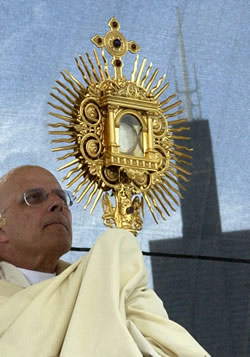
Posted on 09/19/2009 9:59:29 AM PDT by Salvation
Featured Term (selected at random):
The metal receptacle for the consecrated Host, to be reserved in the tabernacle for later exposition in the monstrance.
Catholic Word of the Day – links will be provided later by another FReeper.
|
Book of Zechariah |
Temple (biblical) |
Capsula |
|
|
|
|
Catholic Word of the Day Ping!
Please send me a FReepmail if you would like to be on the Catholic Word of the Day Ping List.

Thanks for posting. Saw it on daily mass on ewtn and wondered what the meaning was. Wonder why they keep it covered under a ‘cozy’ during worship?
Does anyone know the difference between a Capsula and a Luna?
A:
The container that actually holds the eucharist is called a ciborium, it resembles the chalice except it has a lid usually topped with a cross, dove, or image of christ. The eucharist is distributed from the ciborium. The container in which the ciborium is reserved is called a tabernacle. The glass disc that contains a large host for adoration is called a luna, and is kept in a round container called a capsula, the luna is placed in a monstrance during benediction of the blessed sacrament. Both the capsula and the ciborium are covered with a veil within the tabernacle.
Thanks!
A circular receptacle with glass sides, metal circled with gold or gilded metal to hold the Sacred Host upright in the monstrance. It is a sacred vessel, having received the priest's blessing. It is sometimes called a lunette. (Etym. Latin luna, moon.)
I thought the capsula and the luna were the same thing, but apparently not. Perhaps some clergy or someone more knowledgeable than me on board could clarify. Perhaps the capsula holds the luna?
http://en.wikipedia.org/wiki/PyxA pyx or pix (Latin: pyxis, transliteration of Greek: pyxis, box-wood receptacle, from pyxos, box-tree) is a small round container used in the Roman Catholic, Old Catholic and Anglican Churches to carry the consecrated Host (i.e., the consecrated Eucharist), to the sick or invalid or those otherwise unable to come to a church in order to receive Holy Communion. The term can also used in archaeology and art history to describe small round lidded boxes designed for any purpose from antiquity or the Middle Ages, such as those used to hold coins for the Trial of the Pyx in England.
Thank you.
Disclaimer: Opinions posted on Free Republic are those of the individual posters and do not necessarily represent the opinion of Free Republic or its management. All materials posted herein are protected by copyright law and the exemption for fair use of copyrighted works.